Physical Address
304 North Cardinal St.
Dorchester Center, MA 02124
Many congenital urologic malformations and acquired disorders, as well as the results of common urologic surgical procedures, produce visible or palpable findings on physical examination. Some clinical presentations are unique. In other cases, disorders of varying etiology may present similar signs, symptoms, and physical findings. Differential diagnosis is essential to an appreciation of pediatric urologic disorders.
Prior to any physical exam, a thorough history of both the patient and family is key and may prove to be important in consideration of the differential diagnosis of urologic disorders. Family history of urinary tract infection, hydronephrosis, vesicoureteral reflux, cystic kidney disease, compromised fertility, or genital malformation may indicate the presence of heritable urinary anomaly.
Examination begins with a general overview of the patient. Hemihypertrophy, congenital scoliosis, an abnormal gait, facial or external ear deformities, or the presence of multiple congenital anomalies may be associated with urologic disorders. Abdominal examination should begin with inspection for visible masses, followed by gentle palpation. Enlarged kidneys are usually palpable as upper abdominal or flank masses in small children and infants, but they may be difficult to appreciate in older children. An enlarged bladder or lesion of gynecologic origin may be palpable as a midline mass arising out of the pelvis. Abdominal masses should be characterized as cystic or solid; smooth, lobulated, or irregular; fixed or mobile; and tender or nontender. The abdominal portion of an abdominoscrotal hydrocele may be palpable in the left or right lower quadrant and may increase in size when the scrotal component (large hydrocele) is compressed ( Fig. 15.1 ).
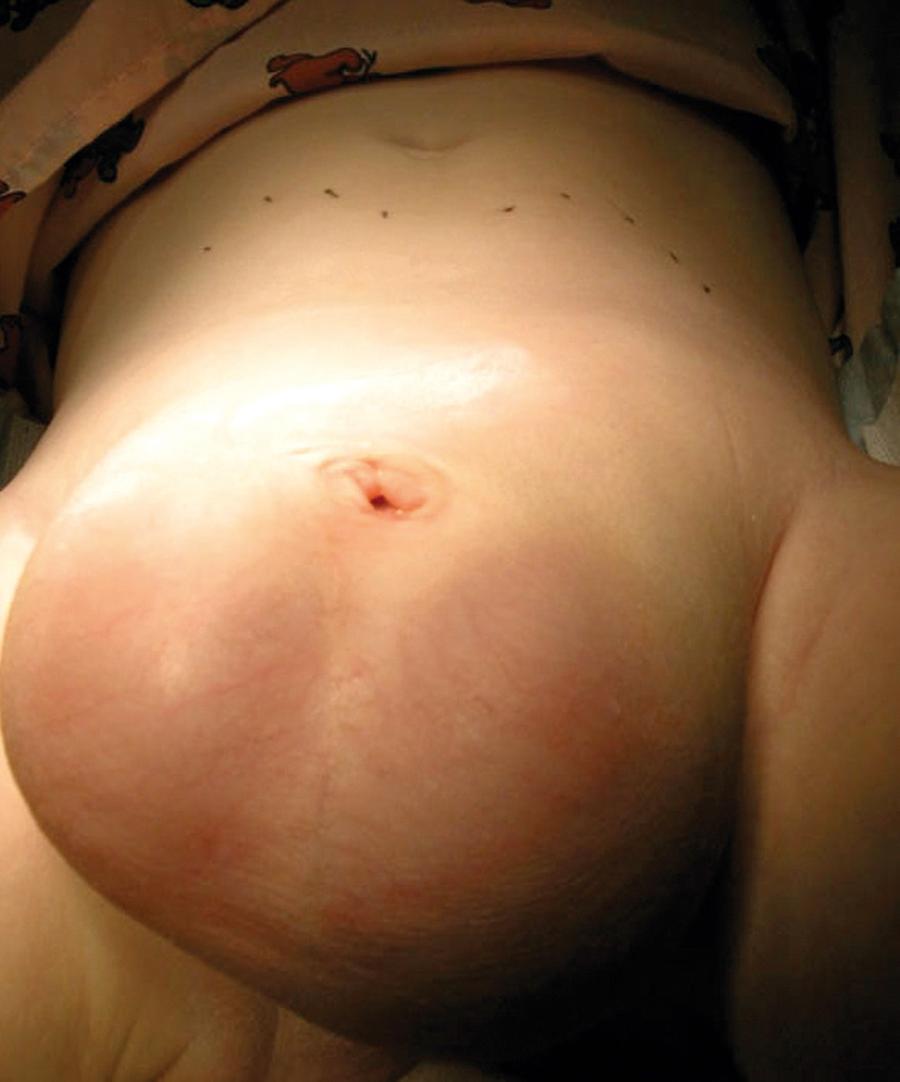
The inguinal areas should be examined for palpable gonads. Gonads palpable in the groin are frequently quite mobile and may move during examination from the inguinal canal almost into the scrotum, or lateral to the scrotum toward the perineum or thigh. They may also move from a palpable position in the groin to disappear into the abdomen during examination; therefore high testes may be palpable on one examination and nonpalpable on the next. The sensitivity of palpation for detection of inguinal testes and other masses may be increased by using soap or lubricant on the examiner’s fingers. It may be difficult to palpate an inguinal testis by trying to “pinch” it between the fingers, whereas lubricated fingers gliding over the inguinal canal may easily detect a gonad as it slides beneath the fingers. The best technique is to place the fingers flat, over the inguinal canal and above the level of the internal inguinal ring, and slide them slowly toward the pubis, then over the pubis toward the scrotum and down over the perineum lateral to the upper scrotum. On occasion, a vas and spermatic cord palpable in the groin (most notably where it passes over the pubic tubercle) may end in a small “nubbin” (remnant of an atrophic testis), which may be palpated in the upper scrotum or just above the scrotum. The structures of the inguinal canal should be examined in a similar fashion to detect thickening of the cord structures that may be seen in the presence of an inguinal hernia or communicating hydrocele. Masses in the inguinal canal may also represent an inguinal hernia containing bowel or omentum, an ovary in girls ( Fig. 15.2 ), communicating hydrocele or hydrocele of the cord, or malignancy of the paratesticular tissues or cord structures (i.e., sarcoma). Inguinal lymphadenopathy is usually detected lateral to the inguinal canal and is generally non-reducible.
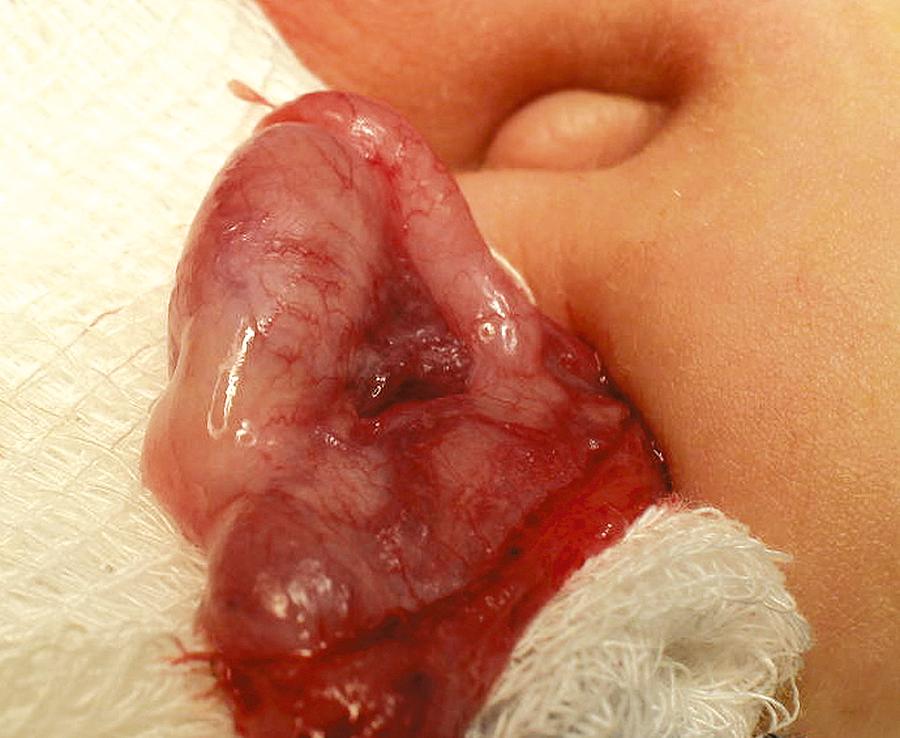
Genital examination should include both inspection and palpation. The penis should be assessed for both length and diameter. Penile stretch length can be determined by using a ruler or tongue blade pressed against the pubic symphysis as the penis is gently stretched alongside it and the position of the tip of the glans marked for measurement. A concealed or buried penis may occur after circumcision or may be congenital. In most cases, hidden penises are retractile, in large part due to a thick suprapubic fat pad. Most cases of buried penis will resolve with time, whereas in severe cases the tethering may be due to dysgenetic fascial attachments and will require surgical correction. It may be difficult to determine the difference between the two in younger boys. Penoscrotal fusion or webbing may also cause an anomalous appearance and entrapment of the penis.
The foreskin should be examined for adhesions to the glans, which may represent merely residual preputial fusion to the glans that will resolve spontaneously, or preputial skin bridges, which can occur after circumcision and require surgical division. The urethral meatus should be examined for size and especially location. The presence of chordee (ventral penile curvature) or a suggestion of its presence should be noted. The size and degree of development of the scrotum, including bifid or hypoplastic anomalies, and the location and size of the testes are determined.
Retractile testes should come well into the dependent portion of the scrotum when the room is warm and the patient is relaxed. If it is difficult to determine whether the testes are undescended, retractile, or normal, repeat examination may be helpful. The epididymis should be palpated and examined for tenderness or the presence of masses. The spermatic cords should be examined for the presence of abnormal findings (thickening, masses, and varicocele). The cord is most easily examined as it crosses over the pubic tubercle. Male patients should be examined in both the supine position and in the standing position with and without Valsalva maneuver.
In the female patient, the introitus should be inspected to confirm a normal size and location of the clitoris, the urethral meatus, the vaginal introitus, and hymenal ring. Labial masses, swelling, or adhesions (fusion) may completely conceal the introitus. Lysis of labial adhesions may be necessary to allow examination of the introitus. Masses protruding from the urethral meatus or located near or originating near the meatus should be noted. Vaginal or urethral discharge, the presence of hymenal tags, or an imperforate hymen may be seen. Posterior displacement of the vaginal introitus with a short or mucosalized perineal body is abnormal. The appearance and position of the anus should be noted, and abnormalities such as skin tags should be carefully noted. Rectal examination may be performed to assess sphincter tone or to help characterize abdominal or pelvic masses.
The lower back should be examined for midline hair tufts, clefts, sinus tracts, or other signs of spinal dysraphism. A general neurologic examination and testing of the anal wink, bulbocavernosus reflex, and lower extremity reflexes should be performed, especially if neurovesical dysfunction is suspected. The bulbocavernosus reflex is assessed by a brisk squeeze of the glans penis or clitoris or a gentle tug on an indwelling Foley catheter. A positive response, which indicates an intact sacral reflex arc, is indicated by reflex contraction of the anal sphincter and bulbocavernosus muscle. Absence of the reflex strongly suggests the presence of a sacral neurologic lesion.
Detection of fetal urinary tract dilation (hydronephrosis, hydroureteronephrosis, pyelectasis, and pyelocaliectasis) with the increased use of prenatal sonography has become common ( Fig. 15.3 ). All fetal urinary tract dilation demands some degree of postnatal evaluation. Most cases of hydronephrosis, even of a significant degree, are not detectable by physical examination of the neonate. Because only the most severe cases present as an abdominal or flank mass, a distended bladder, or generalized increase in abdominal girth and thus lead to immediate uroradiologic evaluation, most questions surround infants with modest fetal hydronephrosis and a normal postnatal physical examination. Causes of urinary tract dilation include physiologic hydronephrosis (which is typically mild and may resolve with time), vesicoureteral reflux (see Chapter 14 for complete review), or obstruction, which encompasses ureteropelvic junction (UPJ) obstruction, ectopic ureters, and outlet obstruction, such as posterior urethral valves in boys or ureteroceles. Isolated upper pole hydronephrosis is diagnostic of a duplicated collecting system and can be seen with ureteroceles or ectopic ureters (see Fig 15.3B ). All infants with evidence of fetal urinary dilation, no matter what degree, should have postnatal ultrasonography and subsequent referral to pediatric urology. We generally recommend postnatal ultrasound after 48 hours of life when feasible prior to hospital discharge ( Fig. 15.4 ). When postnatal ultrasound is normal (spontaneous resolution of fetal hydronephrosis occurs in up to 20% of cases), follow-up ultrasound should be performed at several months and at 1 year because delayed reappearance of dilation has been reported.
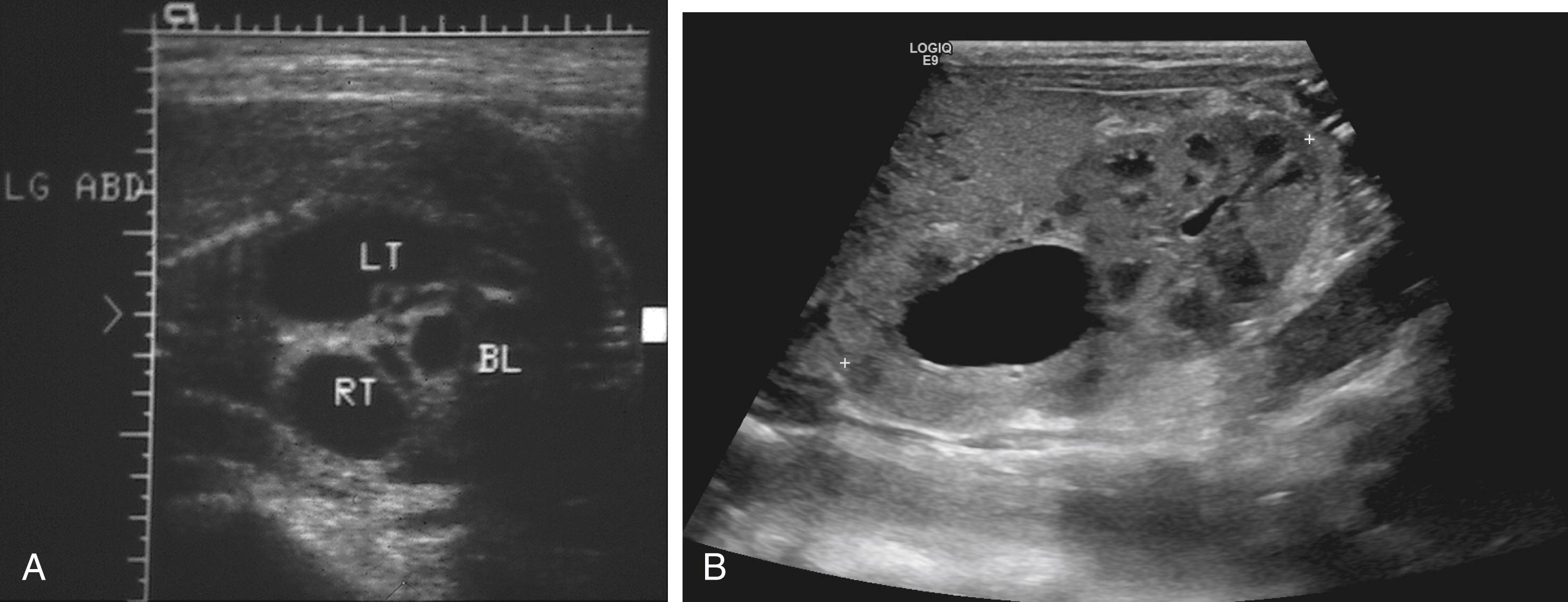
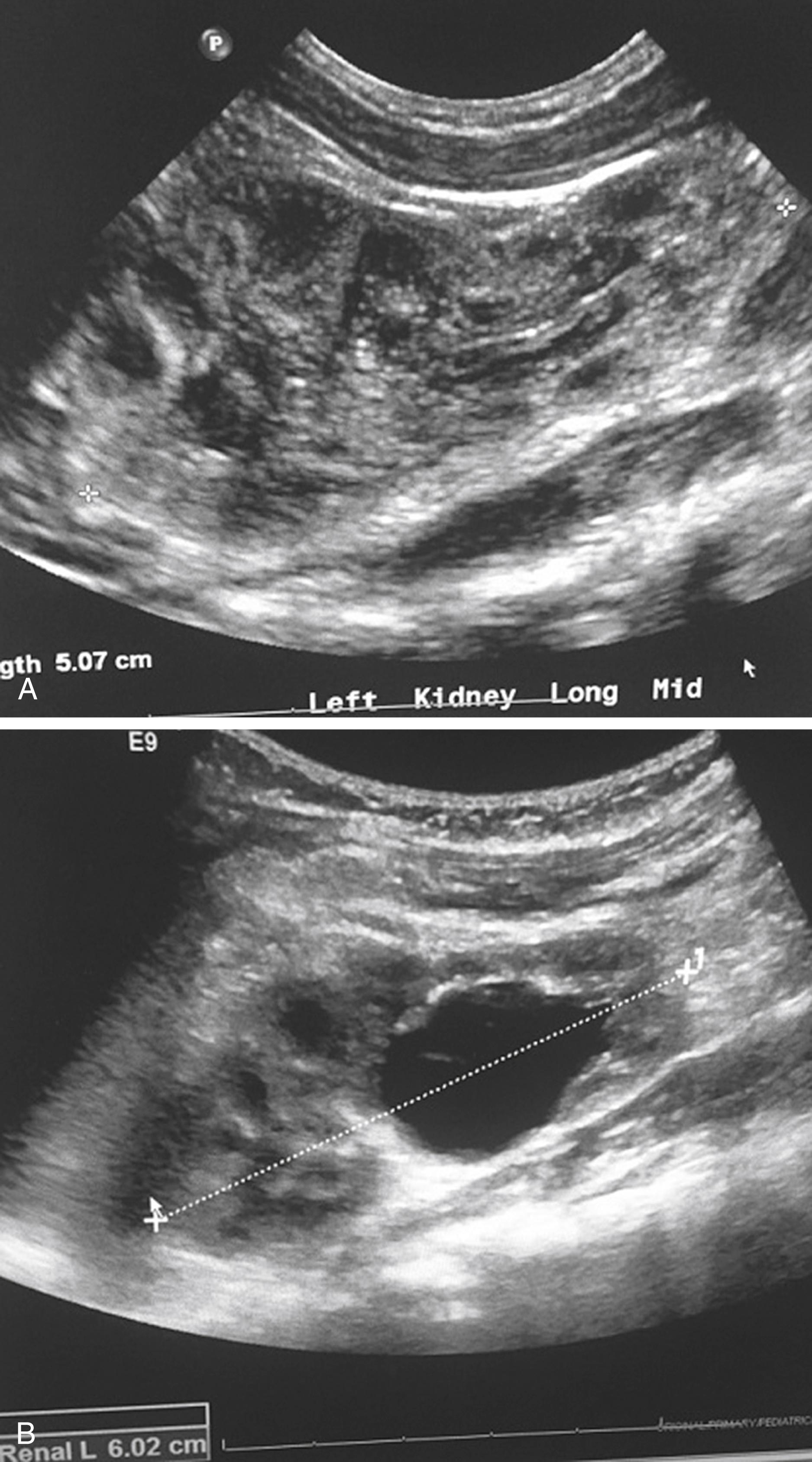
When postnatal hydronephrosis is documented, controversy exists as to the extent of further radiographic evaluation, such as a voiding cystourethrogram. Infants with persistent mild hydronephrosis or resolution on postnatal hydronephrosis may be observed, with the decision to pursue further radiographic evaluation with a voiding cystourethrogram with or without radionuclide scan determined through a discussion between the pediatric urologist and the family. Certain situations, such as severe unilateral or bilateral dilation, poor renal function, or coexistent anomalies, demand complete radiographic evaluation which should be performed as soon as possible prior to the infant leaving the hospital. These patients should also be started on prophylactic antibacterial therapy to prevent urinary tract infection. Voiding cystourethrography (VCUG) is an integral part of the evaluation in severe hydronephrosis and should be the first study performed in all cases to rule out both bladder outlet obstruction (i.e., posterior urethral valves) and vesicoureteric reflux ( Fig. 15.5A ). Subsequent evaluation by radionuclide scan may be appropriate to assess function and to document whether true obstruction or mere dilation is present. If the infant is in stable condition (particularly when the lesion is unilateral or moderate in degree with good renal function), radionuclide evaluation should be delayed for 6 to 8 weeks or longer to allow improved glomerular filtration, making studies more accurate. If nonobstructive dilation is documented, long-term follow-up may document gradual resolution of the hydronephrosis in some cases and persistent dilation in others.
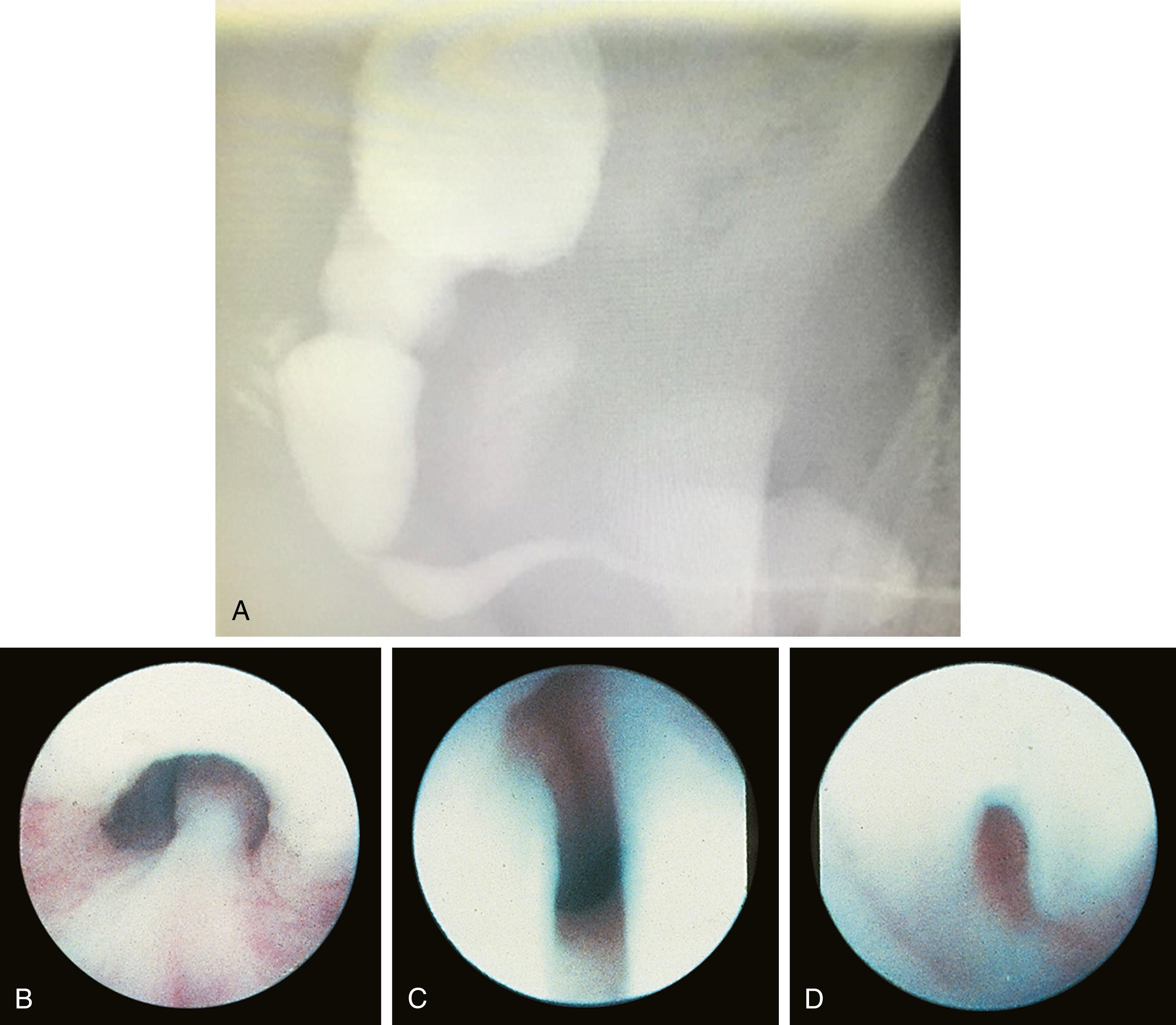
Valvular obstruction of the posterior urethra is a serious cause of bladder outlet obstruction in males. Presentation may vary depending on patient age, as well as severity of obstruction. Most patients today are diagnosed prenatally with ultrasonography showing signs of hydroureteronephrosis, distended bladder, and a thickened bladder wall (see Fig. 15.3 ). Other potential symptoms in older boys include frequent urinary tract infections, voiding dysfunction, or renal failure. Neonates may present with severe pulmonary hypoplasia and renal failure with bladder distention and hydroureteronephrosis. This is due to renal dysplasia in utero resulting in oligohydramnios or anhydramnios. VCUG is the key to diagnosing urethral valves. In most cases, endoscopic fulguration of urethral valves is undertaken (see Fig. 15.5 ). In some cases, cutaneous vesicostomy may be indicated ( Fig. 15.6 ), especially in small infants in whom urethral instrumentation may be problematic. Rarely is upper tract diversion (ureterostomy or pyelostomy) indicated ( Figs. 15.7 and 15.8 ). The ultimate prognosis for renal function depends on the degree of renal dysplasia, overall glomerular filtration and of bladder compliance (poorly compliant bladders with diminished elasticity may fail to allow reflux or hydronephrosis to improve after valve ablation and may be associated with a worse prognosis for continence and renal function).
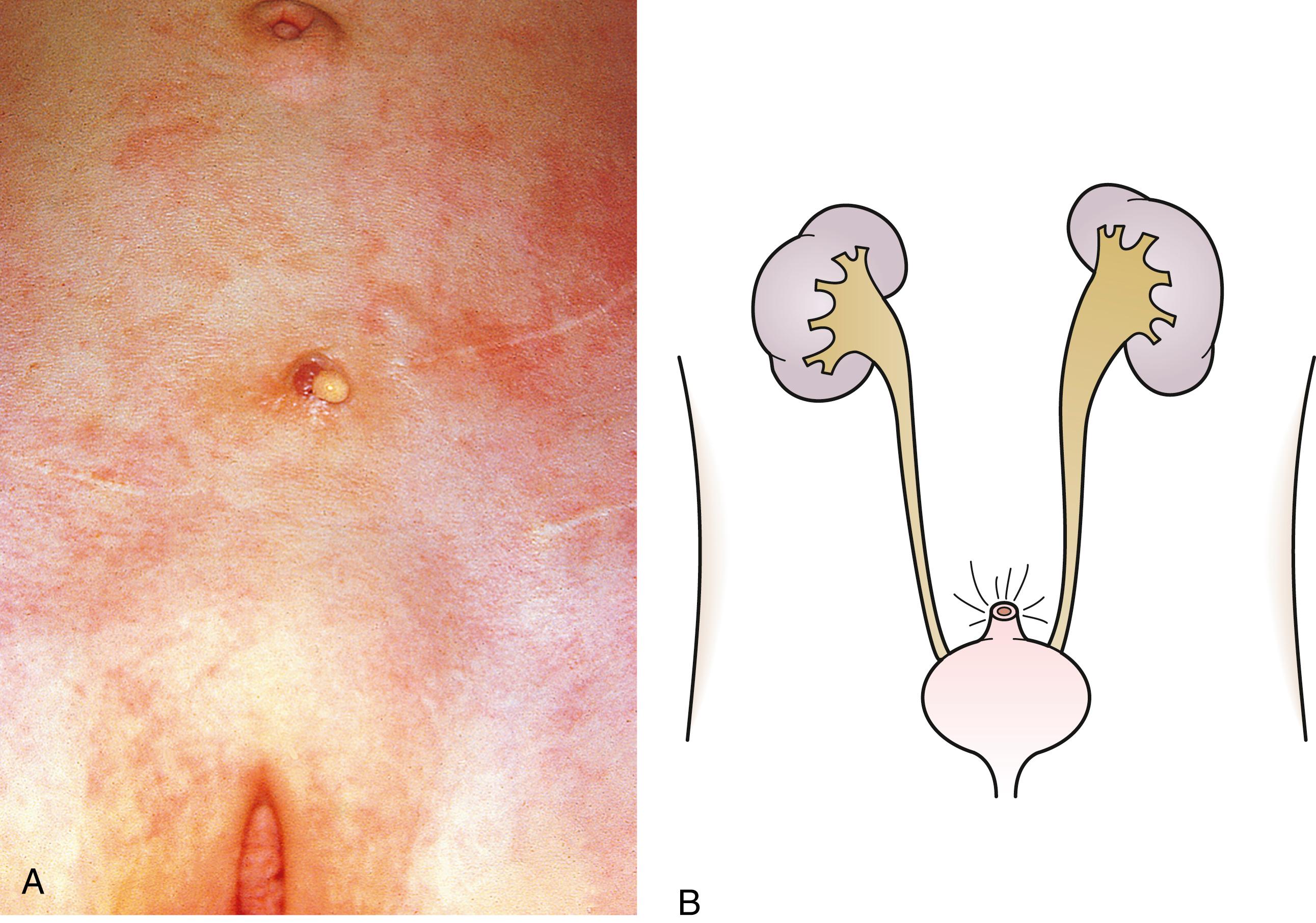
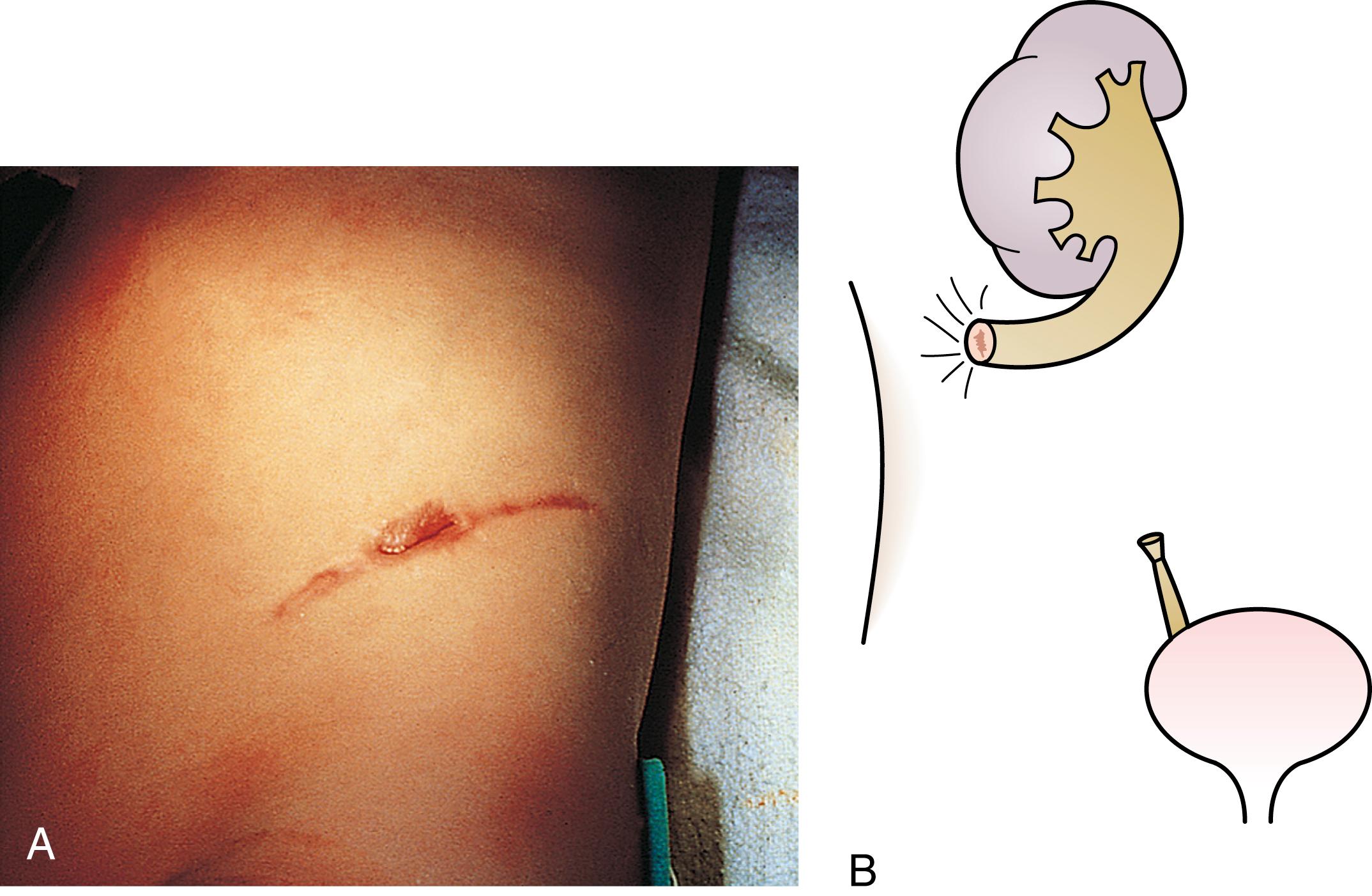
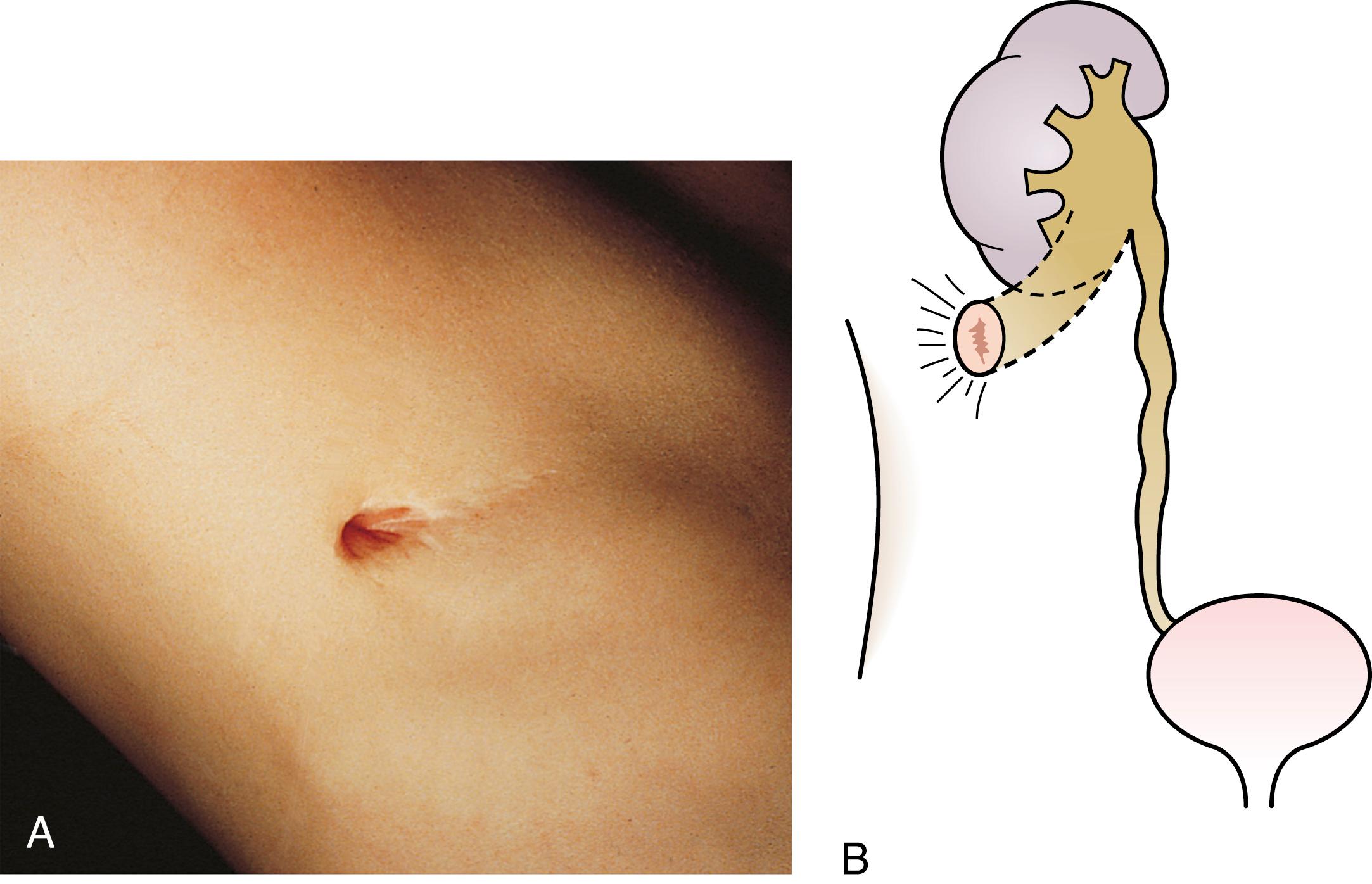
Cryptorchidism is one of the most common pediatric disorders of the male endocrine system, occurring in approximately 33% of premature and 3% of full-term boys. Approximately three-fourths of cryptorchid testes will spontaneously descend by 3 months old. Patients born with undescended testes are at increased risk for testicular malignancy, and those with bilateral cryptorchidism are at risk for infertility, highlighting the need to document testicular descent. The American Urological Association (AUA) released guidelines in 2014 for the evaluation and treatment of boys with cryptorchidism. A gestational history at the initial evaluation and a physical exam with palpation of the turgor and placement of the testes should be conducted at every visit with the primary care provider. Infants with a history of cryptorchidism that have not experienced spontaneous descent by 6 months old (corrected for gestational age) should be referred to urology. Some boys with possible testicular ascent or newly diagnosed cryptorchidism after 6 months old should also be referred. Specifically in the AUA guidelines, there is no role for ultrasound or other imaging in the valuation of boys with cryptorchidism prior to referral, because these studies do not assist in decision making. In phenotypic males with bilateral, nonpalpable testes, immediate consultation for evaluation of possible disorders of sex development (DSD) is indicated. Hypospadias associated with even unilateral cryptorchidism should raise the question of DSD, and karyotype should be determined in the neonate ( Fig. 15.9 ). When bilateral nonpalpable testes are present in infancy and congenital adrenal hyperplasia is ruled out, providers may measure müllerian inhibiting substance (MIS) to evaluate for anorchia.
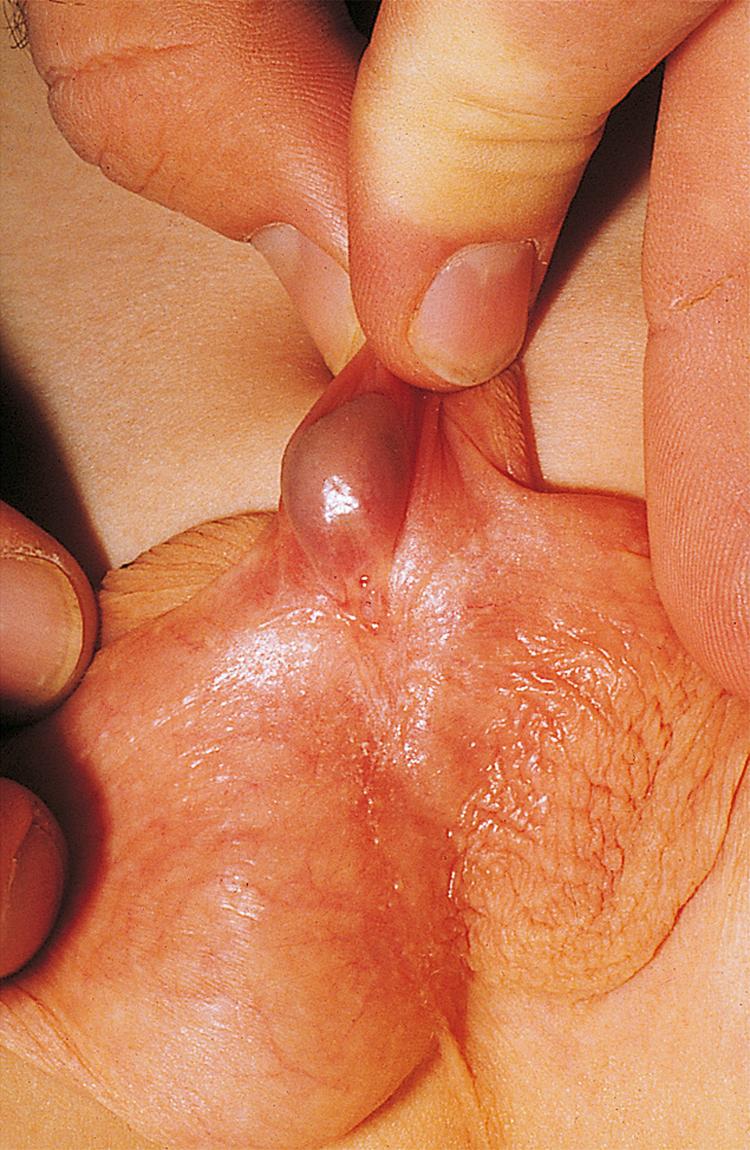
Hormonal therapy is not recommended to induce testicular descent, because there is a lack of evidence for long-term efficacy and evidence showing low response rates. Surgical intervention should be performed within a year after the initial 6-month-old (corrected for gestational age) confirmation of undescended testes. In boys with retractile testes, yearly exams to assess for secondary ascent are indicated.
Prune-belly syndrome (PBS) has a fascinating constellation of physical findings and occurs almost exclusively in boys at a rate of 1 in 35,000 to 50,000 live births. The triad includes abnormal abdominal musculature (variable degrees of muscular laxity, which may be asymmetrical); abdominal cryptorchidism; and floppy dysmorphic urinary tracts, most with vesicoureteric reflux (see Fig. 14.21 ). Plain abdominal radiography demonstrates the bell-shaped thorax and abdomen seen in this syndrome. The typical prune-belly refluxing ureter, with increasing tortuosity in the lower portion, is revealed by voiding cystourethrogram. Because of the severe risk of sepsis associated with urinary tract infection, urethral catheterization should be undertaken only with the utmost care to prevent infection and with antibiotic prophylaxis. Megalourethra can be associated with PBS. Cryptorchidism should be treated with surgical intervention early in life. Associated with the syndrome in most patients are prostatic hypoplasia and dimples on the lateral aspects of the knees, which some experts believe are secondary to an exaggerated cross-legged position in utero. Gastrointestinal and cardiac anomalies occur in a proportion of patients, but the factor that most determines longevity is the presence and degree of renal dysplasia.
The urachus extends from the bladder dome to the umbilicus and is a vestigial structure during extrauterine life. Patent urachus results when the urachal lumen fails to obliterate, and the bladder communicates with the umbilicus. Several lesions may result from persistence of the urachus: patent urachus, vesicourachal diverticulum, urachal cyst, and umbilical-urachal sinus ( Fig. 15.10 ). Many of these lesions go unrecognized for long periods before becoming symptomatic. Umbilical drainage is the most common presentation, but inflammation or infection may also result. Infected remnants are first treated with antibiotics and incision and drainage, with subsequent surgical excision. Imaging modalities can include bladder ultrasound, voiding cystourethrogram, or computed tomography (CT) scan. The differential diagnosis includes persistent omphalomesenteric duct. Urachal remnants not resolving spontaneously should be excised with inclusion of the bladder cuff because of the increased risk for later adenocarcinoma formation. Many “urachal” lesions in newborns turn out to be merely localized umbilical granulomas.
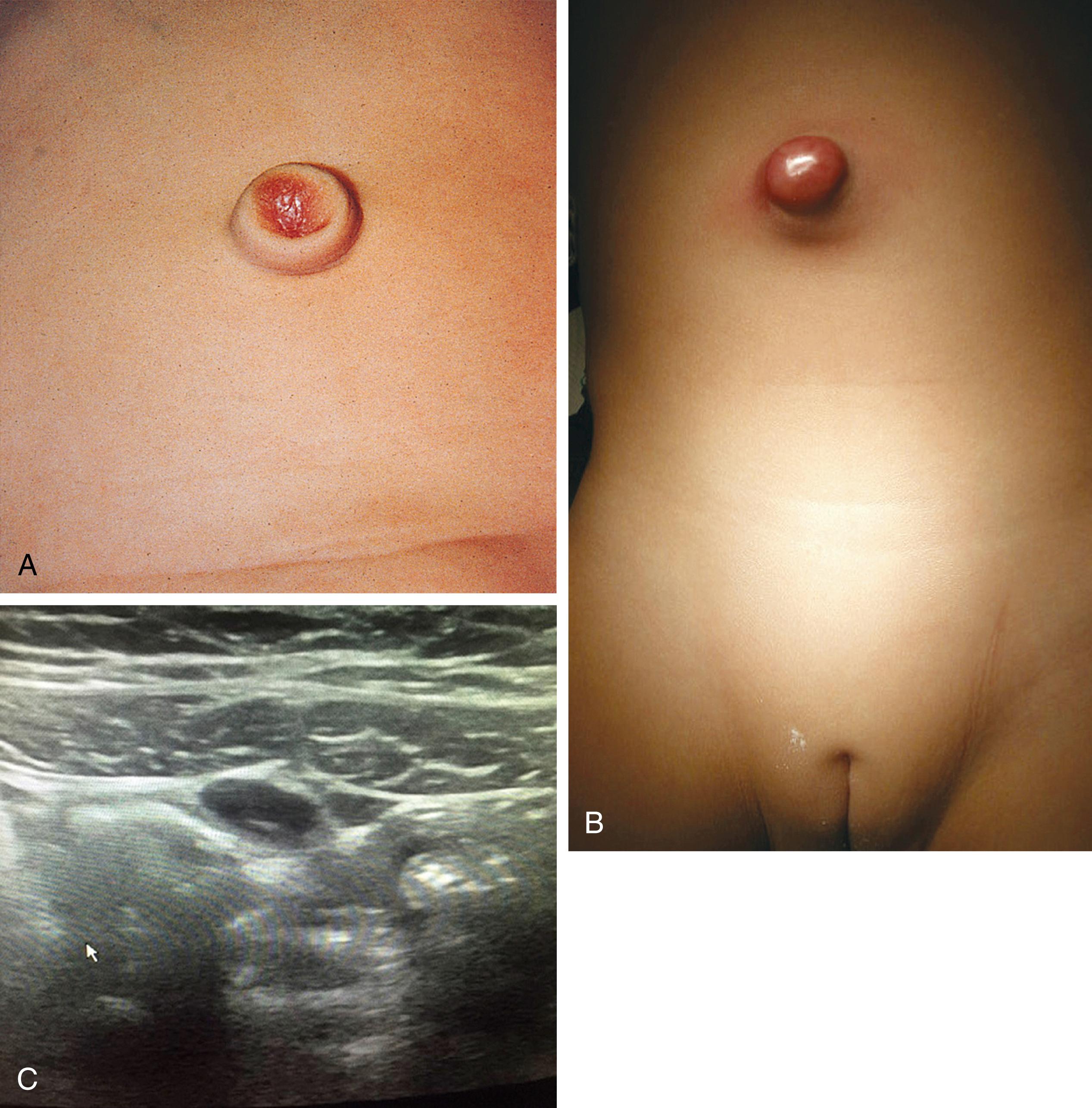
Lesions of the UPJ are a common cause of hydronephrosis. UPJ obstruction may present as antenatal hydronephrosis, neonatal flank mass, urinary tract infection, recurrent stone formation in affected kidney, or recurrent episodes of abdominal/flank pain in the older child and adolescent (termed Dietl crises). UPJ obstruction may be documented by ultrasound and confirmed by radionuclide diuresis renography (Lasix renal scan) ( Fig. 15.11 ) or retrograde pyelography, which may be performed at the time of repair ( Fig. 15.12A ). Primary UPJ obstruction can be caused by intrinsic narrowing at UPJ, extrinsic compression from an aberrant lower pole vessel or ureteral polyps. Secondary UPJ obstruction can be due to high-grade vesicoureteric reflux resulting in significant ureteral tortuosity that causes a kink at the UPJ. For that reason, VCUG is important, particularly in infants, because vesicoureteric reflux may coexist with UPJ obstruction. In cases with vesicoureteral reflux (VUR) (see Fig. 15.12B ), diluted contrast noted in the renal pelvis compared with the bladder and ureter is indicative of a secondary UPJ obstruction. Not all hydronephrotic kidneys are truly obstructed, and a Lasix renal scan will assess both the function and drainage of the kidney. Some dilated but unobstructed infant kidneys spontaneously return to a normal or near-normal appearance with time.
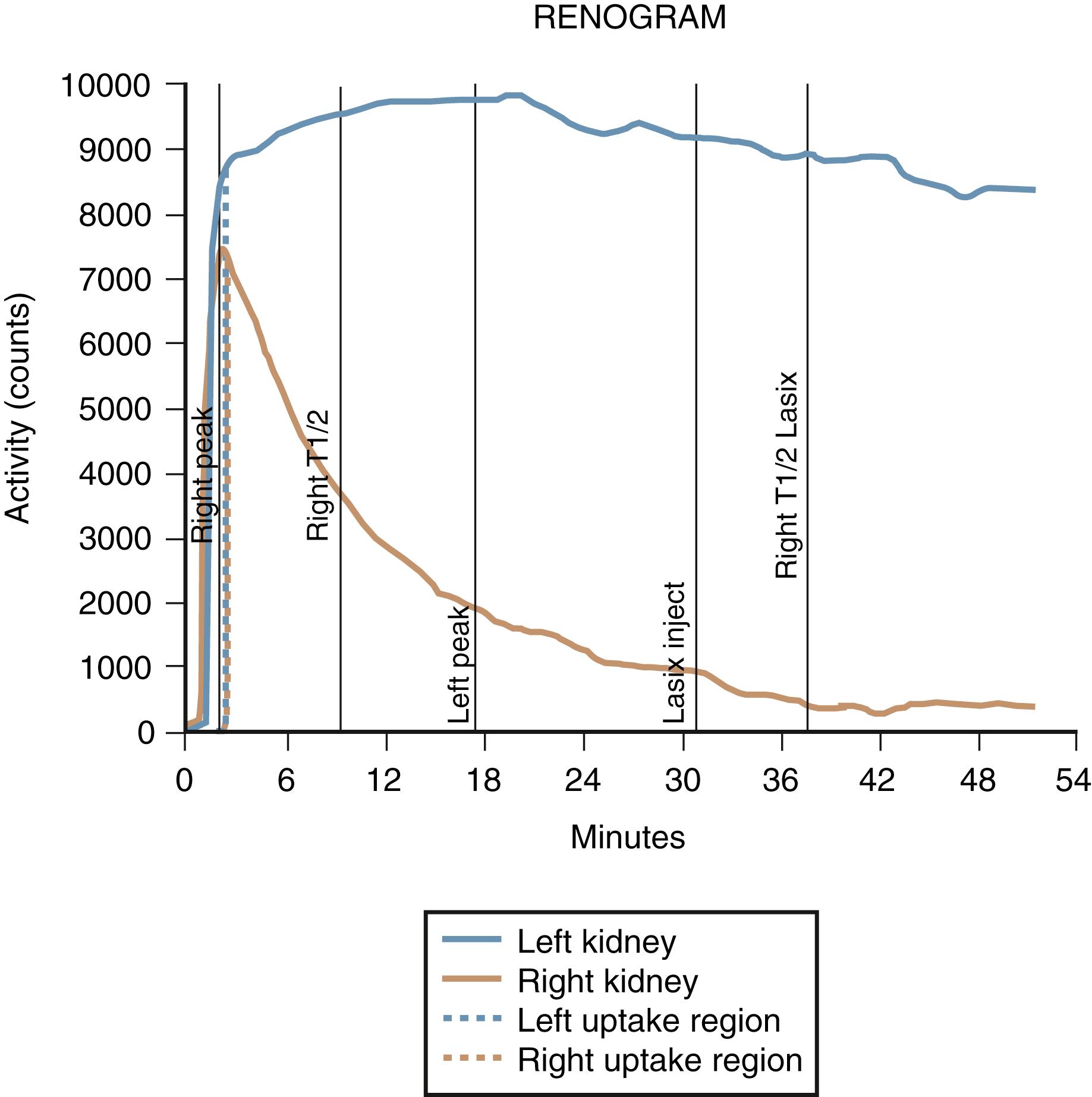
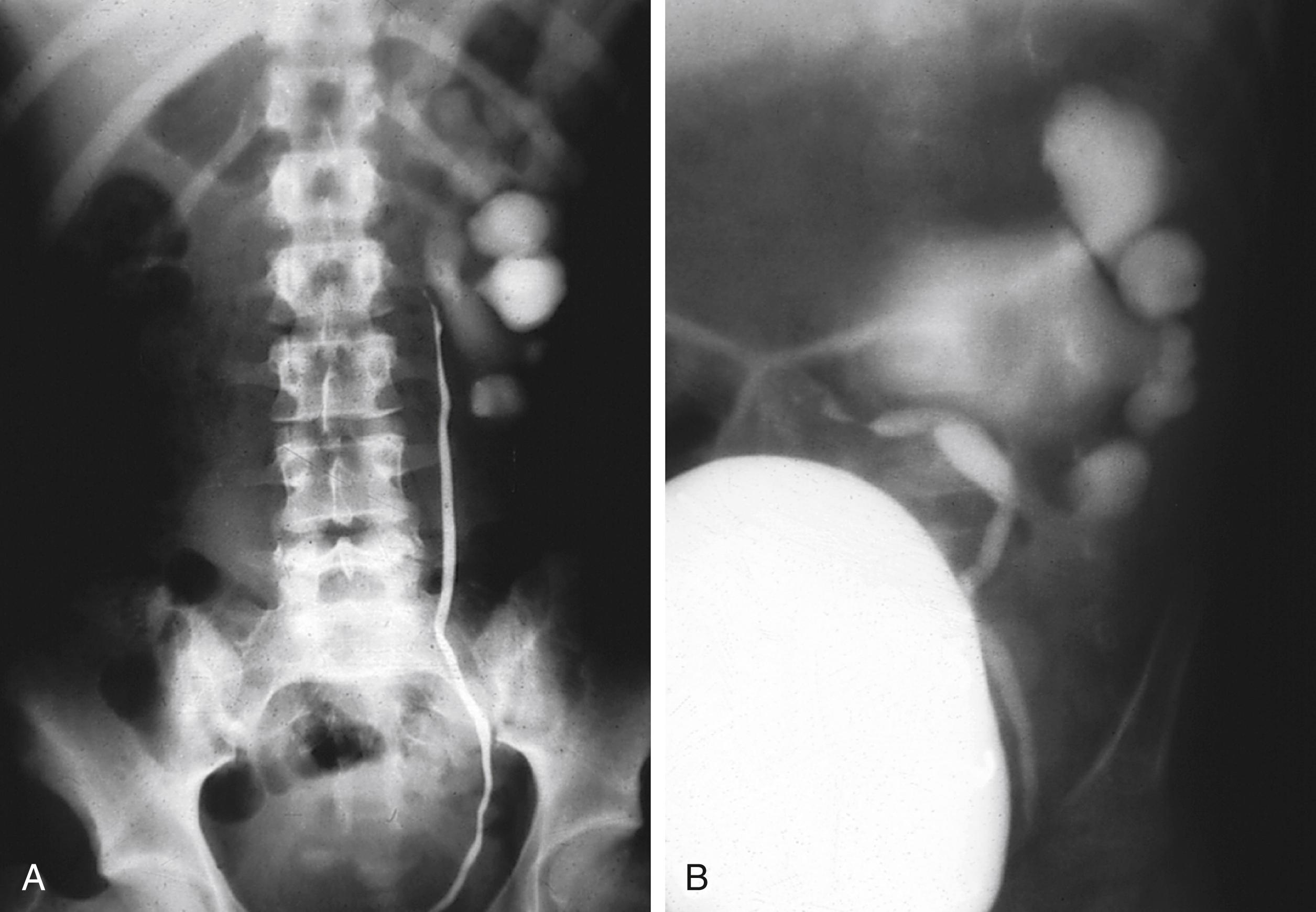
Multicystic renal dysplasia (see Chapter 14 ) is the second most common cause of renal enlargement in the neonate and may be discovered by antenatal ultrasound or during the evaluation of an abdominal mass. Multicystic renal dysplasia must be differentiated from hydronephrosis with imaging. The combination of ultrasonography and radionuclide scan is usually diagnostic because, although the ultrasound appearance may be similar, multicystic kidneys rarely function on scan ( Fig. 15.13 ). Contralateral vesicoureteric reflux can be seen in 18% to 43% of infants, and some authors believe that VCUG should be performed to detect reflux into the solitary functioning kidney. A large percentage of multicystic kidneys spontaneously involute on follow-up ultrasonography—it may be that many cases of “congenitally absent kidney” represent unrecognized involution of a multicystic dysplastic kidney. There is no clear indication for nephrectomy unless an increased amount of significant amount of solid tissue is present. Large series have indicated no association with an increased risk for hypertension or neoplasm, although case reports exist. Patients should be followed conservatively with frequent blood pressure measurements by the primary care provider.
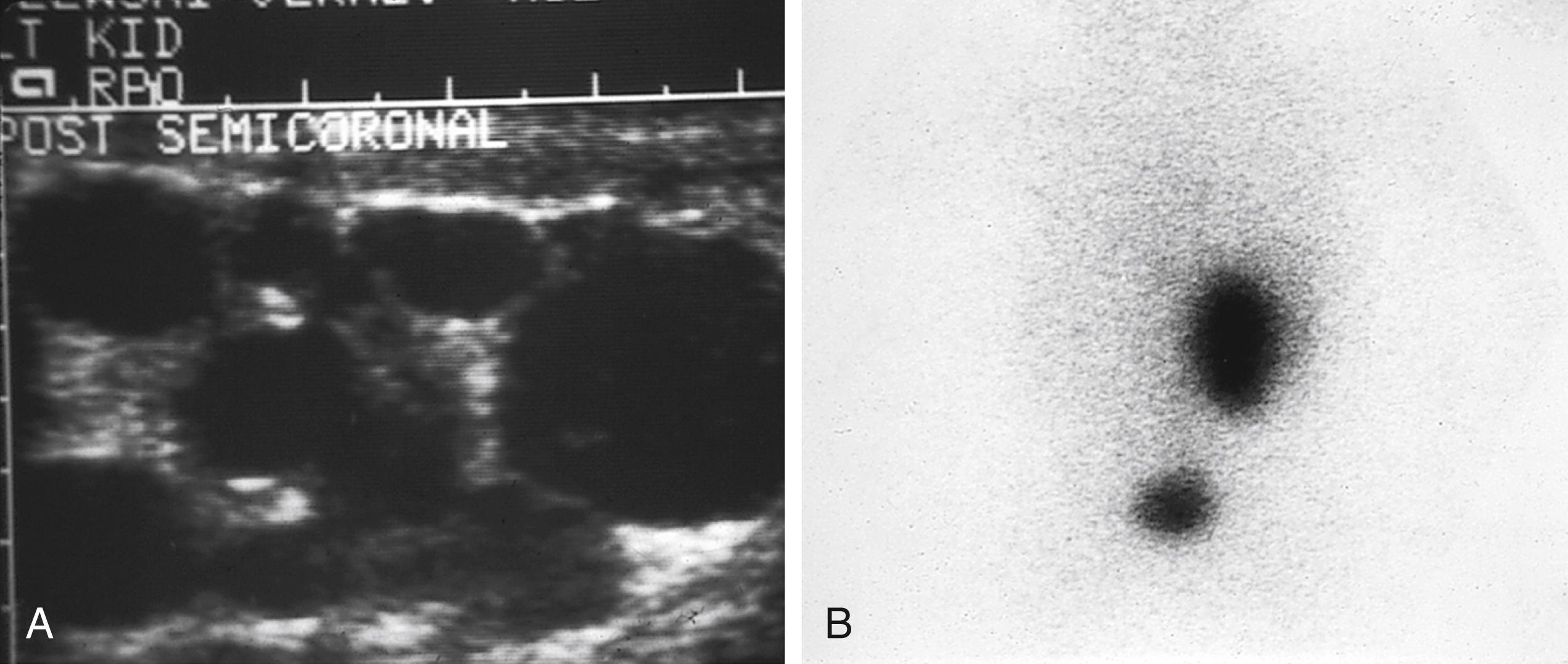
Simple renal cysts were thought to be rare in children until the advent of high-resolution ultrasound technology. They are now frequently detected, albeit much less commonly than in adults, in whom the incidence increases with age. As a result, the traditional admonition to surgically explore all cysts in children has been replaced by a policy of longitudinal radiographic follow-up evaluation similar to that in adults. Simple cysts should be treated as benign. Most renal cysts are discovered serendipitously while evaluating the urinary tract for infection-related symptoms, but large cysts occasionally present as abdominal masses. Radiologic evaluation usually includes ultrasonography, but CT ( Fig. 15.14 ) and even cyst puncture for aspiration and contrast studies may be used to confirm the nature of the cyst. The differential diagnosis includes cystic Wilms tumor, multilocular cystic dysplasia, and duplication anomaly with hydronephrosis, caliceal diverticulum, and adult polycystic disease.
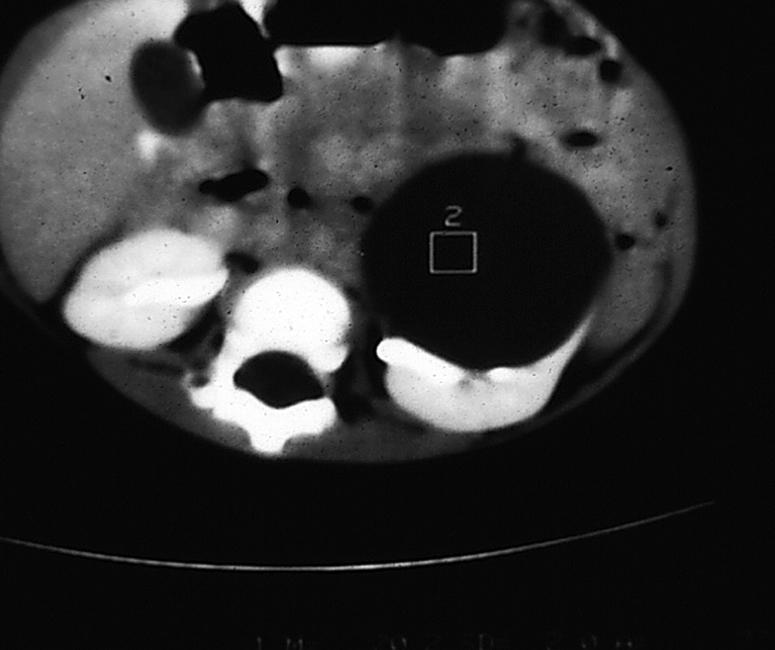
Bladder exstrophy occurs in approximately 1 of every 40,000 live births. It predominates in boys and is thought to result from premature rupture of the cloacal membrane. The infant is usually otherwise healthy. Examination reveals a red mucosal surface of varying size on the infraumbilical abdominal wall, which represents the entire bladder opened as a book. On the inferior bladder surface, the trigone and ureteral orifices are visible, freely effluxing urine. The penis is epispadiac and lies dorsally tethered against the bladder. When the penis is retracted downward, the entire mucosal surface of the urethra is seen to be splayed open ( Fig. 15.15A and B). In severe cases the penis may be bifid or rudimentary, and gender may be questionable. The scrotum may be normal or bifid, and testes may be undescended. Inguinal hernias are common. The pubic symphysis is widespread. In girls a hemiclitoris and duplicate vagina are common (see Fig. 15.15C and D ). The delicate bladder surface should be kept moist and covered with plastic wrap until urologic consultation is obtained. The umbilical cord should be tied off with a 2-0 silk rather than a clamp that could irritate the bladder mucosa. Prompt upper tract evaluation is necessary. Timing of closure is dependent upon the urologist, but there has been a shift toward delaying closure for various reasons, including anesthetic purposes, size of bladder, and possibility of staged reconstruction. When closure is delayed, pelvic osteotomy is likely necessary to achieve successful closure.
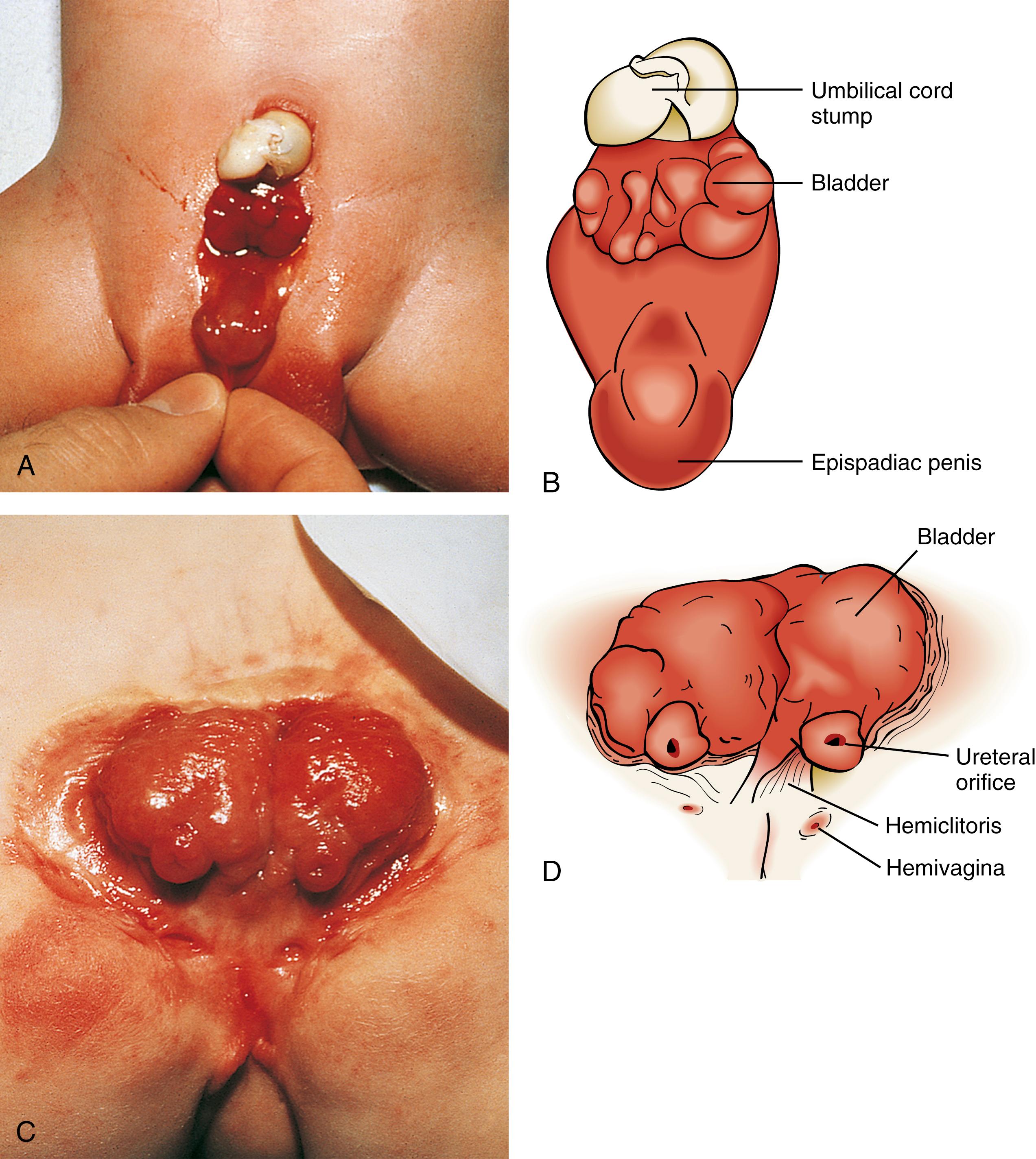
Cloacal exstrophy is a rare anomaly (1 in 200,000 births). It represents an embryologic mishap similar to that in classic bladder exstrophy, except that rupture of the cloacal membrane occurs before the urorectal septum has completed its descent to separate the hindgut from the bladder. The resulting constellation of anomalies is severe, with long-term survival little better than 50% in most cases. Most children have a large omphalocele, and the majority have myelomeningocele and hydrocephalus. Examination of the exstrophic mucosa reveals that the bladder is divided into two widely separated halves, with a strip of bowel mucosa in the middle ( Fig. 15.16 ). This strip is the ileocecal segment, usually accompanied by a long, prolapsed tubular structure, which is the terminal ileum. Separate orifices enter the appendix (or appendices) and a short, blind colon. The anus is imperforate. The genitalia are usually hypoplastic with the genital primordia widely separated at either side of the exstrophic cloaca. A multispecialty approach should be taken to the infant with cloacal exstrophy, including questions of gender assignment.
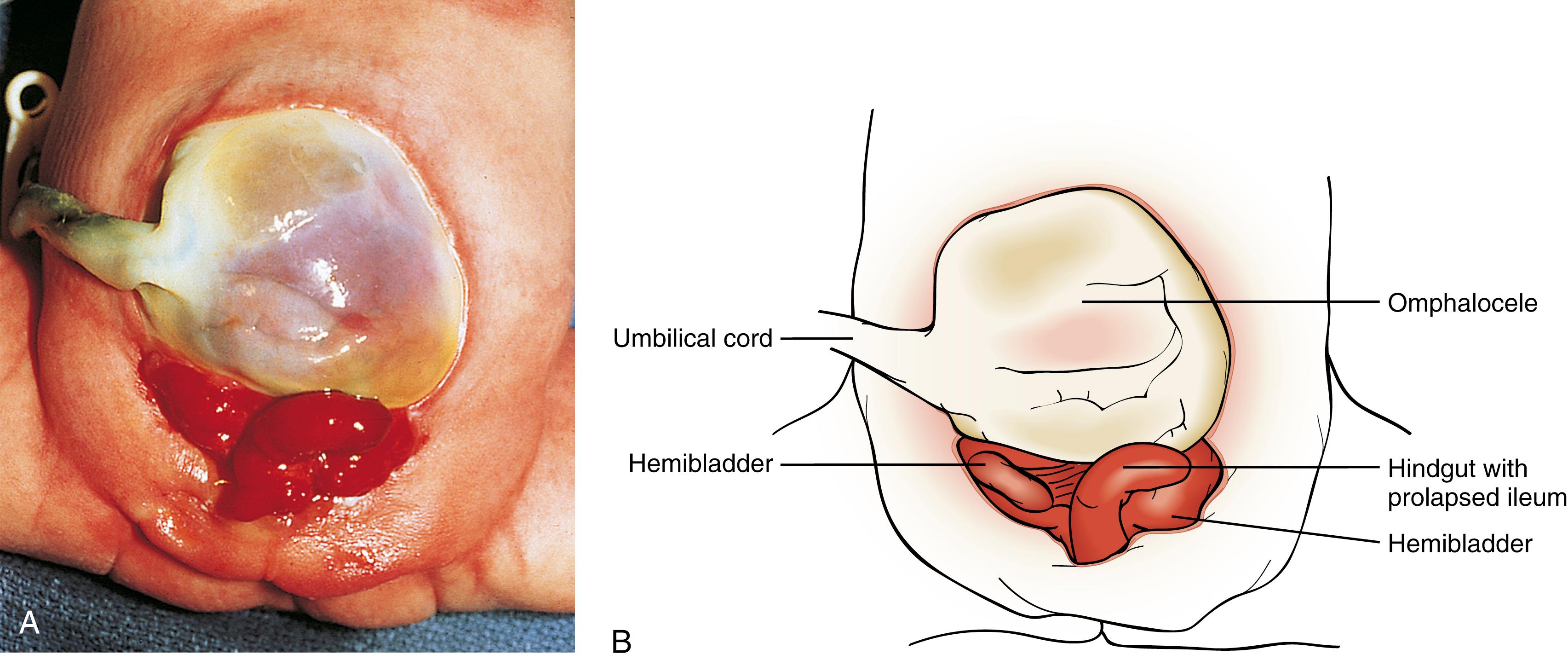
Epispadias represents the less severe end of the spectrum of exstrophic anomalies and has a spectrum of severity. Approximately 55% of patients are boys with penopubic epispadias and urinary incontinence. These boys have a palpably and radiographically widened pubic symphysis and a broad, spade-like penis with the urethra opened fully on its dorsal surface up to the level of the bladder neck. The penis is usually tethered dorsally, and the patient is usually incontinent ( Fig. 15.17A ). A smaller percentage of boys demonstrate only penile or balanitic (glanular) epispadias. These boys have normal urinary continence. In girls with epispadias (the most rare cases of epispadias), incontinence is usually accompanied by a wide urethra and a bifid clitoris (see Fig. 15.17B ). The cosmetic appearance of the genitalia in both genders can be improved by genitoplasty, but the larger problem is incontinence, which is accentuated by small bladder capacity. Surgical correction is the rule and may be performed in stages. Renal ultrasonography and VCUG should be performed in all cases.
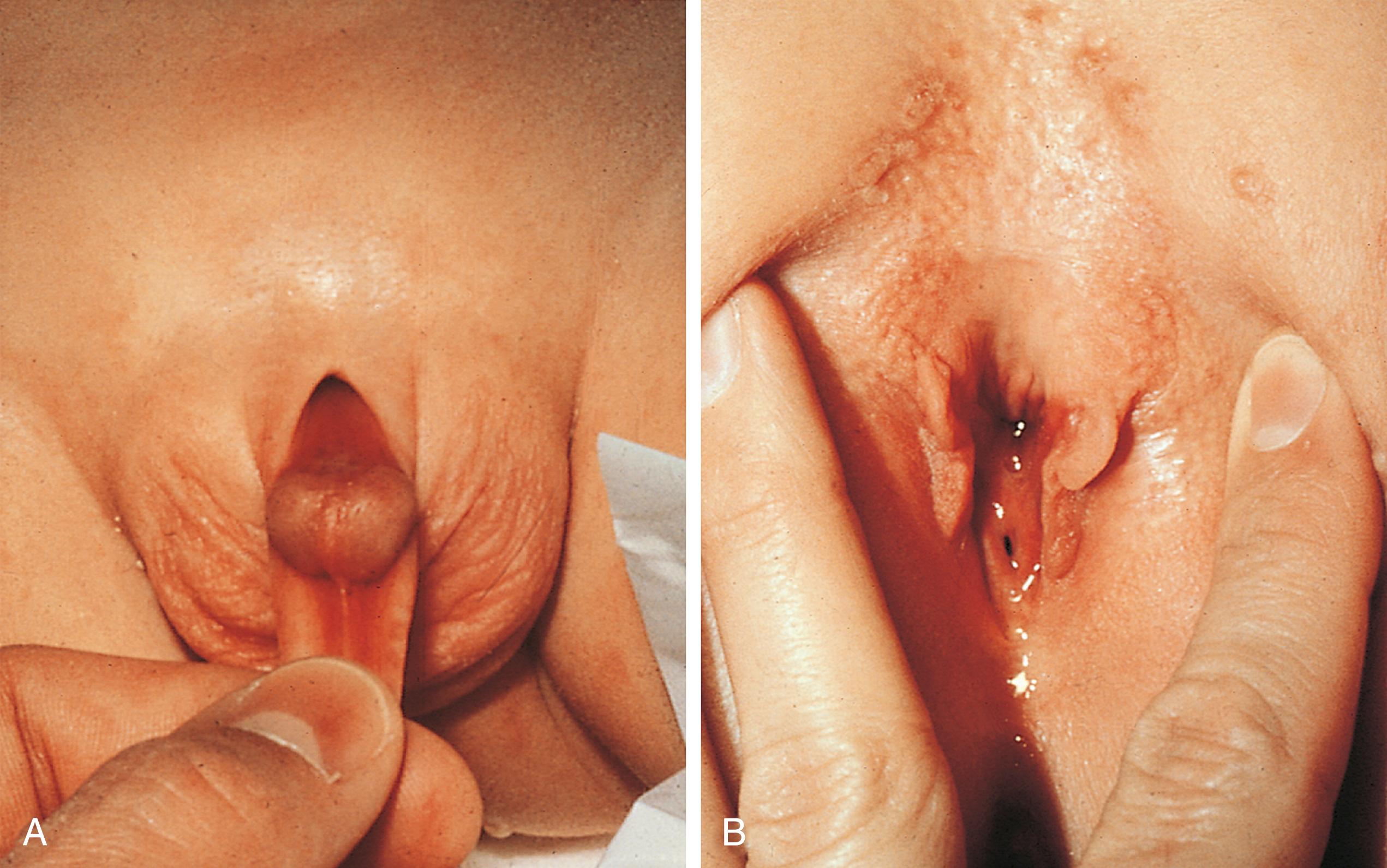
Acute urinary retention in infants and children is usually voluntary and associated with severe acute cystitis, urethritis, meatitis (in boys), or vaginitis. Severe constipation is frequently associated with urinary retention. In boys, urethral stricture (congenital, traumatic) and meatal stenosis with meatitis should be considered ( Fig. 15.18A ). Urethral valves are more likely to cause dysuria or straining without complete retention. Retention in girls is unlikely to be caused by even severe labial adhesions, so uncommon lesions (e.g., a prolapsed ureterocele) should be considered. Bladder or urethral calculi can also cause retention, and these can be diagnosed by a plain abdominal film and ultrasound examination (see Fig. 15.18B ). Pelvic masses (bladder, prostate, or genital rhabdomyosarcoma or other malignancy) ( Fig. 15.19 ); uterine or ovarian masses; hydrocolpos; or hydrometrocolpos secondary to imperforate hymen or vaginal atresia, sacrococcygeal tumors, or tumors of neural origin may cause retention due to neurologic involvement of the sacral nerve roots or due to bladder neck or urethral compression. Acute neurologic changes associated with spinal cord injury or tumor or transverse myelitis may cause neurogenic retention. Intermittent catheterization may be extremely valuable in managing the bladder until diagnostic evaluations can be completed.
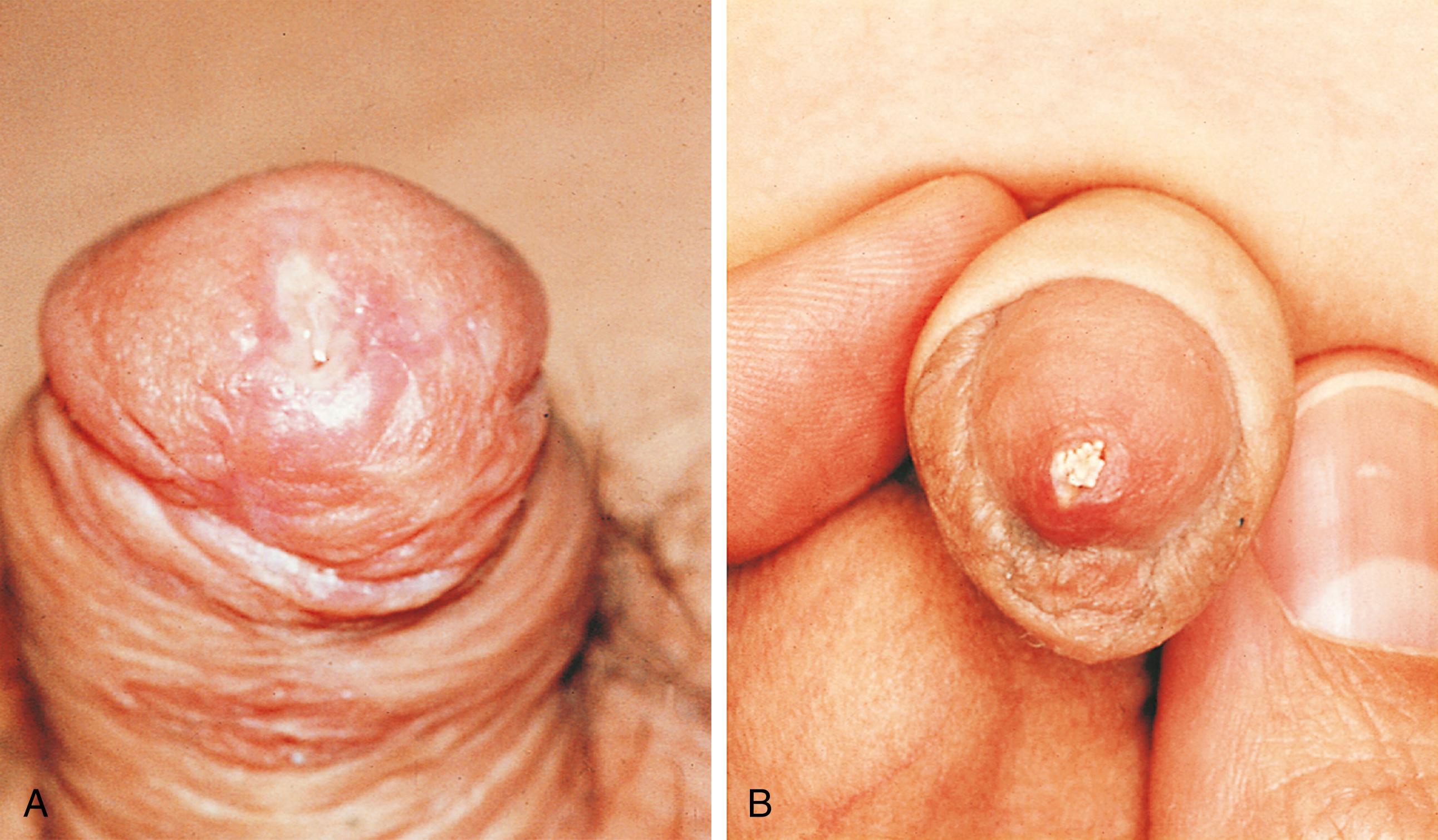
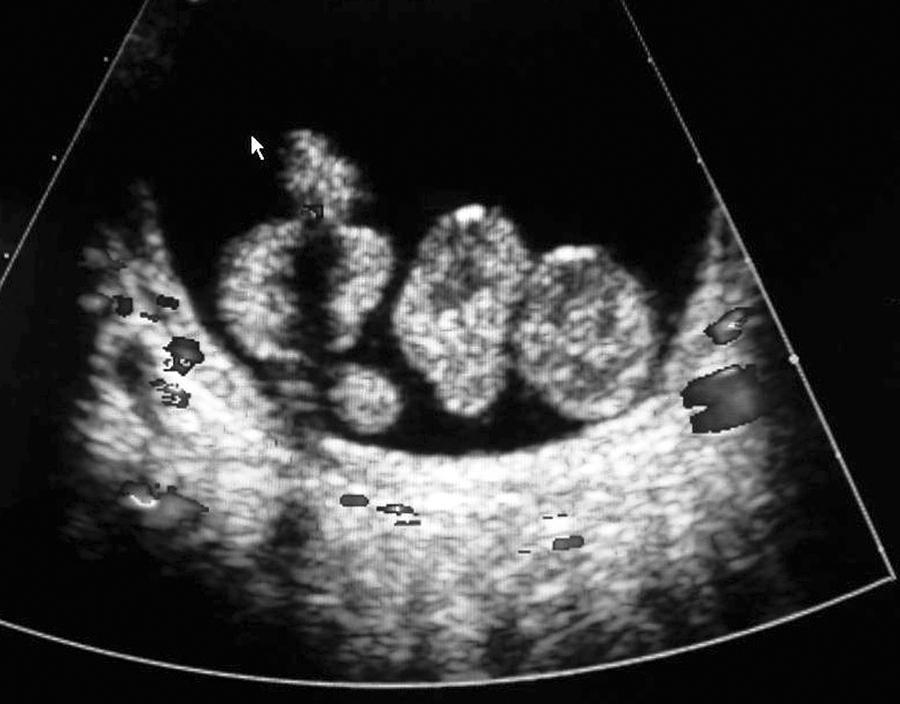
Neurovesical dysfunction in childhood may be either congenital (meningocele, myelomeningocele, intradural lipoma, diastematomyelia, sacral agenesis) or acquired (trauma, transverse myelitis, spinal cord tumor). Independent of etiology, the evaluation and management of the child with neurovesical dysfunction are extremely important to preserve renal function, prevent renal damage from infection, and provide social continence. Physicians caring for an infant with neurovesical dysfunction should ensure that periodic evaluation of the child’s urinary tract is carried out. This evaluation may include radiographic or urodynamic studies, which should be repeated several times during the first year of life or after an initial injury and at least yearly thereafter or as indicated. Danger signs may include frequent infection, fever, or a change in normal pattern of bladder or bowel continence ( Fig. 15.20 ).
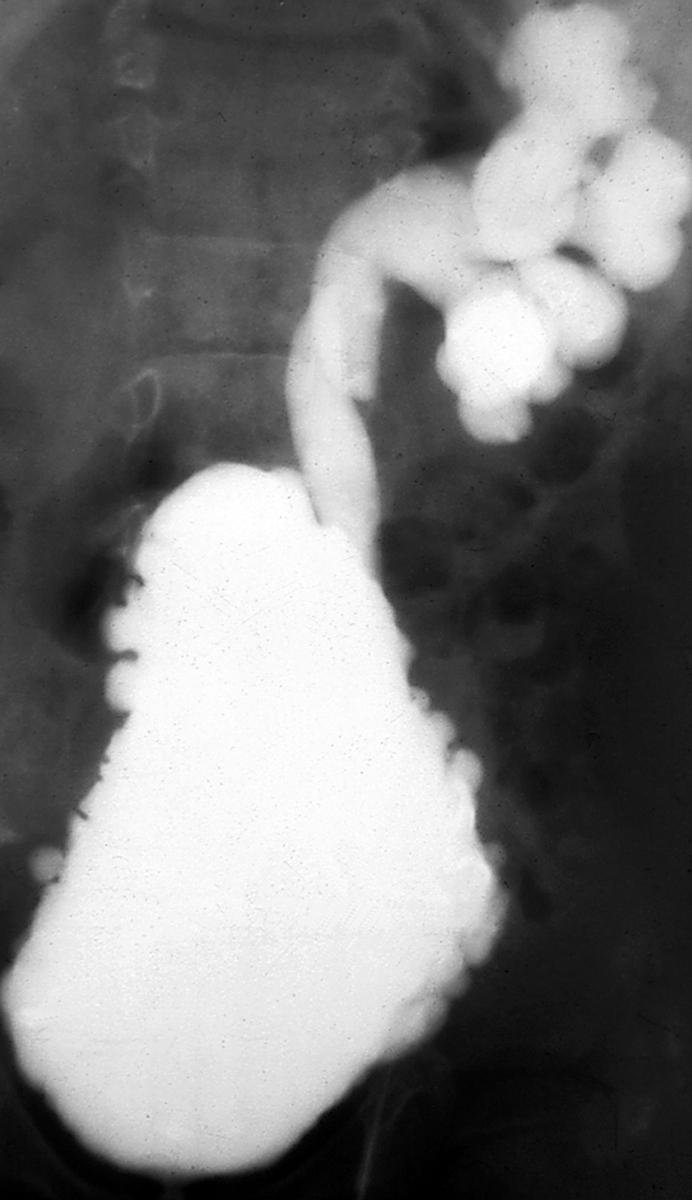
Uninhibited bladder contractions and discoordinated voiding may be seen in other neurologic conditions, and these may result in bladder dysfunction severe enough to cause not only incontinence or retention of urine but also upper tract deterioration. Multiple sclerosis and other demyelinating diseases are examples. Severe cerebral palsy is frequently associated with incontinence, although upper tract deterioration is uncommon.
The “nonneurogenic neurogenic bladder,” or what is termed Hinman-Allen syndrome, is a rare but important entity that may result in incontinence and renal failure. This syndrome represents a learned disorder of micturition and usually presents as day and night incontinence, fecal soiling, and urinary tract infection. Many of these children display behavioral problems. This syndrome seems to be at the far end of the spectrum of the frequency syndrome of childhood; along with its slightly more prevalent and symptomatic cousin, dysfunctional voiding, these two symptomatic diagnoses are seen with increasing frequency by pediatricians and pediatric urologists. Most children with dysfunctional voiding have some degree of incontinence and fecal soiling. Some have urinary urgency to the point of incontinence, although overflow incontinence from a full bladder may also occur (the lazy bladder syndrome). On occasion, the child may display disordered micturition without symptoms of incontinence and may have only urinary tract infection as a symptom of the dysfunction. In severe cases in which bladder function is severely disordered and detrusor/sphincter dyscoordination is severe, the child’s bladder may appear to have the configuration of a bladder that has suffered damage from infravesical obstruction or neurovesical dysfunction ( Fig. 15.21 ).
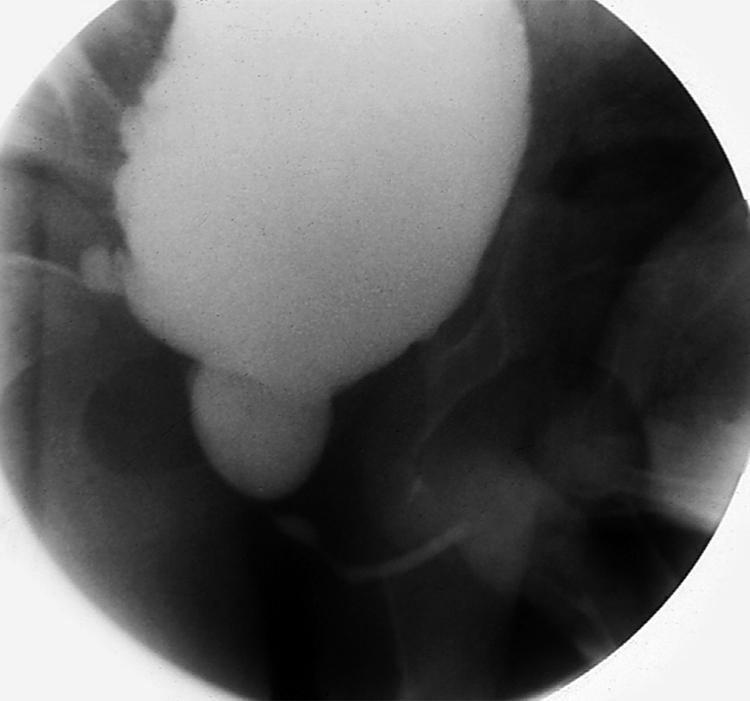
The diagnosis of dysfunctional voiding is one of exclusion, made after ruling out occult neuropathy, such as a tethered spinal cord (magnetic resonance imaging [MRI] scan of the lumbosacral spine) and infravesical obstruction (voiding cystourethrogram and urodynamic evaluation), because the uroradiographic findings often mimic neurovesical dysfunction or obstruction. If child and family are cooperative, bladder retraining using a timed, double-voiding regimen may be effective, frequently augmented with biofeedback. In severe cases, intermittent catheterization may be necessary to reverse hydronephrosis. When renal function is in jeopardy and patient cooperation is minimal, temporary urinary diversion may be appropriate. Many children with this disorder require behavioral or psychological therapy in combination with thoughtful urologic management.
Hypospadias is a common anomaly that occurs in approximately 1 in 300 male births. The configuration of the urethra varies from mild glanular hypospadias to severe perineal hypospadias with chordee (ventral penile curvature). In describing the appearance of the hypospadiac penis, it is important to be as detailed in the description. Proper definition of the anomaly should give an accurate description of the location of the meatus (megameatus, glanular, coronal, subcoronal, distal shaft, midshaft, proximal shaft, penoscrotal, scrotal, perineal), the presence or absence of chordee, and the appearance of the scrotum ( Fig. 15.22 ). When hypospadias is associated with cryptorchidism, karyotype should be determined. VCUG is not indicated in hypospadias except in severe lesions or in boys with a history of urinary tract infection. Renal sonography is more likely to be abnormal in boys with proximal hypospadias. Infants with hypospadias should not be circumcised, because the dorsal preputial skin may be necessary for urethral and penile reconstruction. Repair is usually undertaken in nonglanular hypospadias at approximately 6 months of age or older.

Become a Clinical Tree membership for Full access and enjoy Unlimited articles
If you are a member. Log in here